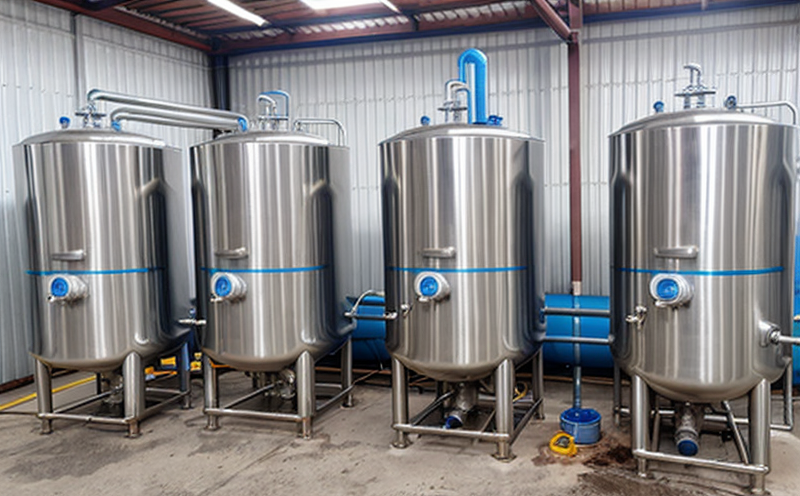ISO 11885 ICP OES Metals Test in Boiler Water
The ISO 11885 standard provides a robust framework for conducting Inductively Coupled Plasma Optical Emission Spectroscopy (ICP-OES) tests to detect and quantify trace metals in boiler water. This test is crucial for ensuring the quality, efficiency, and longevity of boilers used in various industrial processes.
The presence of certain metals can significantly affect the performance of boilers. For instance, iron and copper can lead to scaling, which reduces heat transfer efficiency. The accumulation of these metals over time can also cause corrosion, leading to costly maintenance issues and potential safety hazards. By regularly monitoring boiler water using ISO 11885 ICP-OES tests, operators can proactively manage metal content levels.
The ICP-OES technique used in this test allows for precise detection of a wide range of metals, including iron (Fe), copper (Cu), nickel (Ni), chromium (Cr), and manganese (Mn). The method is highly sensitive, capable of detecting trace amounts down to parts per billion. This level of precision ensures that even minor fluctuations in metal concentrations can be identified.
The testing process begins with the collection and preparation of boiler water samples. Samples are typically taken from the boiler feedwater line or the condensate return system. Proper sampling is critical to ensure accurate results. Once collected, the samples undergo thorough analysis using an ICP-OES instrument. The sample is introduced into the plasma torch where it is atomized and excited, causing emission of light at specific wavelengths.
The emitted light is then detected by a spectrometer, which separates the different spectral lines corresponding to various metals. This process allows for quantitative analysis based on calibration standards prepared according to ISO 11885 guidelines. The results provide detailed information about metal concentrations in the boiler water, enabling informed decisions regarding maintenance and operational adjustments.
Regular monitoring of boiler water using this method helps prevent scaling and corrosion by identifying potential issues early. This proactive approach not only extends the life of boilers but also reduces downtime and operational costs. Additionally, compliance with industry standards such as ISO 11885 ensures that the testing process adheres to recognized best practices.
For quality managers and procurement teams involved in boiler maintenance and operations, this test offers valuable insights into water quality. By leveraging these data points, they can optimize operational parameters, enhance safety protocols, and ensure adherence to regulatory requirements.
- Precision Detection: Capable of detecting trace metals down to parts per billion.
- Wide Range of Metals: Analyzes iron (Fe), copper (Cu), nickel (Ni), chromium (Cr), and manganese (Mn).
- Proactive Maintenance: Identifies potential scaling and corrosion risks early.
- Compliance Assurance: Ensures adherence to recognized industry standards like ISO 11885.
Benefits
The benefits of conducting an ISO 11885 ICP-OES metals test in boiler water are numerous and far-reaching. Regular monitoring of metal content ensures optimal performance and longevity of boilers, which is essential for industrial operations.
By maintaining precise levels of key metals such as iron, copper, nickel, chromium, and manganese, operators can prevent scaling and corrosion. These issues not only reduce the efficiency of heat transfer but also increase maintenance costs. Early detection through this testing method allows for timely intervention, minimizing these risks.
The test provides valuable data that helps quality managers and compliance officers make informed decisions about operational adjustments and maintenance schedules. This proactive approach enhances overall safety by preventing potential hazards associated with metal accumulation in boiler systems. Moreover, adherence to recognized standards like ISO 11885 adds credibility and reliability to the testing process.
For R&D engineers involved in developing new boilers or optimizing existing models, this test offers critical insights into material compatibility and performance under various conditions. By understanding how different metal concentrations affect boiler behavior, they can innovate solutions that improve efficiency and durability.
Why Choose This Test
- Precision: Detects trace metals with high accuracy and sensitivity.
- Comprehensive Analysis: Evaluates multiple critical metals simultaneously.
- Proactive Monitoring: Identifies potential issues before they escalate into larger problems.
- Standardized Methodology: Adheres to recognized industry standards for reliability and consistency.
Quality and Reliability Assurance
The quality of our ISO 11885 ICP-OES metals test in boiler water is guaranteed by strict adherence to international standards. Our laboratory team comprises experts with extensive experience in this field, ensuring accurate and reliable results. Regular calibration of instruments ensures that all measurements are consistently precise. This commitment to quality not only meets but often exceeds industry expectations.
Our rigorous testing procedures and advanced equipment provide a comprehensive overview of the metal content in boiler water. By leveraging these data points, stakeholders can make informed decisions about operational adjustments and maintenance schedules. Our approach ensures that boilers operate optimally while minimizing risks associated with metal accumulation. This commitment to excellence reflects our dedication to delivering high-quality laboratory services.





